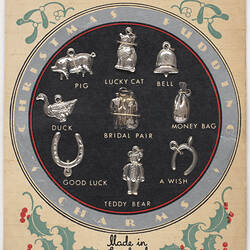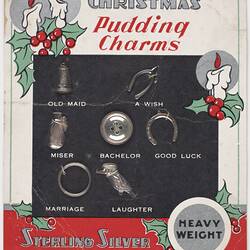Summary
Card with unused 'Christmas Pudding Charms' sewn on: pig, lucky cat, bell, duck, bridal pair, money bag, horseshoe (good luck), teddy bear and wishbone (a wish). It was probably made in the 1930s-1950s. It was purchased at a garage sale and donated to the Museum. It comes with no precise provenance and is apparently unused.
Such sterling silver pieces were added to the batter of Christmas plum puddings. They were light-heartedly used to suggest the 'fortune' of the recipient for the next year. Sometimes silver coins were used instead. The meanings of charms vary according to cultural context, so it is not surprising that some of the charms in this example have meanings included.
An article published in the Adelaide Express & Telegraph, 29 November 1913, explains that 'Already people are buying their charms for their Christmas plum puddings and cakes. These charms, among others, are a donkey, a little duck, piggie, belle (a bell), imp and spoon. A special set of plum pudding and cake jewellery for lucky charms includes a swastika (long life), bell (marriage), coin (fortune yours), piggie (good luck), bogey man (be happy) and lucky shoe.' In preparation for Christmas 1941, the Queensland Times helpfully provides a Christmas plum pudding recipe, concluding the ingredients with: 'lastly add three tablespoons brandy, and, of course, the traditional charms and pieces of silver' (22 Dec).
Physical Description
Yellow card, 'Made in England', with nine Christmas pudding sterling silver charms sewn on: pig, lucky cat, bell, duck, bridal pair, money bag, horseshoe (good luck), teddy bear and wishbone (a wish). Card decorated with holly berries and leaves. Charms are cast metal, lightweight.
Significance
The tradition of putting silver objects and coins into the Christmas pudding has largely disappeared (Australian coins are no longer solid silver; families are conscious of the danger of swallowing 'foreign objects'.) These are relics of a time when British traditions were followed more rigorously in Australia than they are generally today.
More Information
-
Collecting Areas
-
Acquisition Information
Donation from Mr John Sumby, 28 Apr 2003
-
Place & Date Made
-
Inscriptions
Text: 'STERLING SILVER / PIG/LUCKY CAT / BELL / DUCK / BRIDAL PAIR / MONEY BAG / GOOD LUCK / TEDDY BEAR / A WISH / Made in / England'.
-
Classification
-
Category
-
Discipline
-
Type of item
-
Overall Dimensions
11.5 cm (Length), 9.2 cm (Width)
-
References
1913 'CHARMS OLD AND NEW.', The Express and Telegraph (Adelaide, SA : 1867 - 1922), 29 November, p. 8. , viewed 15 Dec 2021, [Link 1] 1941 'THE CHRISTMAS MENU.', Queensland Times (Ipswich, Qld. : 1909 - 1954), 22 December, p. 6. (DAILY.), viewed 15 Dec 2021, [Link 2]
-
Keywords



